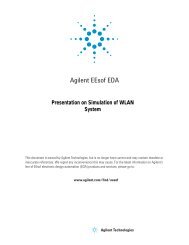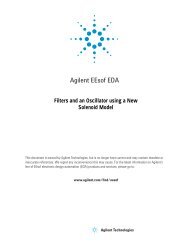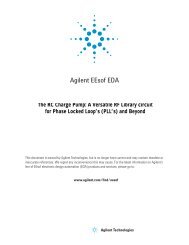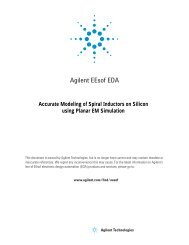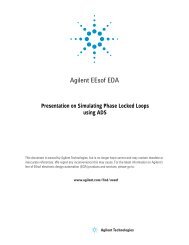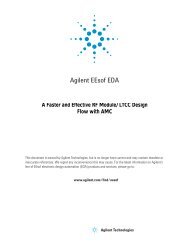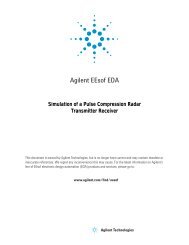Presentation on RF Predistortion of Power Amplifiers - Agilent ...
Presentation on RF Predistortion of Power Amplifiers - Agilent ...
Presentation on RF Predistortion of Power Amplifiers - Agilent ...
Create successful ePaper yourself
Turn your PDF publications into a flip-book with our unique Google optimized e-Paper software.
Technology Overview<br />
Linearizati<strong>on</strong> approaches:<br />
• FeedForward Linearizati<strong>on</strong><br />
– Based <strong>on</strong> inherently wideband technology<br />
• Digital Predistorti<strong>on</strong><br />
– Limited Bandwidth (DSP implementati<strong>on</strong>)<br />
• Cartesian Feedback<br />
– Stability c<strong>on</strong>siderati<strong>on</strong>s limit bandwidth and accuracy<br />
• LINC<br />
– Sensitive to comp<strong>on</strong>ent drift and has a high level <strong>of</strong> complexity<br />
• Dynamic Biasing<br />
– Limited ACI suppressi<strong>on</strong><br />
• <strong>RF</strong>-Based Predistorti<strong>on</strong><br />
– Limited accuracy <strong>of</strong> functi<strong>on</strong> model<br />
– Implemented at <strong>RF</strong> with low complexity<br />
– Adaptati<strong>on</strong> is required<br />
4<br />
Of the various linearizati<strong>on</strong> techniques that have been developed, predistorti<strong>on</strong> is the<br />
most comm<strong>on</strong>ly used. The c<strong>on</strong>cept behind predistorti<strong>on</strong> calls for the inserti<strong>on</strong> <strong>of</strong> a<br />
n<strong>on</strong>linear module between the input signal and the power amplifier. The n<strong>on</strong>linear<br />
module generates IM distorti<strong>on</strong> that is in anti-phase with the IM distorti<strong>on</strong> produced by<br />
the power amplifier, thereby reducing out-<strong>of</strong>-band emissi<strong>on</strong>s.<br />
The <strong>RF</strong>-based predistorter has two distinct advantages over other approaches. First, the<br />
correcti<strong>on</strong> is applied before the power amplifier where inserti<strong>on</strong> loss is less critical.<br />
Sec<strong>on</strong>d, the correcti<strong>on</strong> architecture has a moderate bandwidth.<br />
Digital predistorti<strong>on</strong> technique are more complex, but provide better IM distorti<strong>on</strong><br />
suppressi<strong>on</strong>. However, bandwidths are low due to limited DSP computati<strong>on</strong>al rates.<br />
Cartesian feedback are relatively less complex and <strong>of</strong>fers reas<strong>on</strong>able IM distorti<strong>on</strong><br />
suppressi<strong>on</strong>, but stability c<strong>on</strong>siderati<strong>on</strong>s limit the bandwidth to a few hundred KHz.<br />
The LINC technique c<strong>on</strong>verts the input signal into two c<strong>on</strong>stant envelope signals that are<br />
amplified by Class C amplifiers, and then combined, before transmissi<strong>on</strong>. C<strong>on</strong>sequently,<br />
they are very sensitive to comp<strong>on</strong>ent drift.<br />
Dynamic biasing is similar to predistorti<strong>on</strong>, however the work functi<strong>on</strong> operates <strong>on</strong> the<br />
power amplifier’s operating bias.<br />
Feedforward linearizati<strong>on</strong> is the <strong>on</strong>ly strategy that simultaneously <strong>of</strong>fers wide bandwidth<br />
and good IM distorti<strong>on</strong> suppressi<strong>on</strong>. The price for this performance is higher complexity.<br />
Automatic adaptati<strong>on</strong> is essential to maintain performance.





